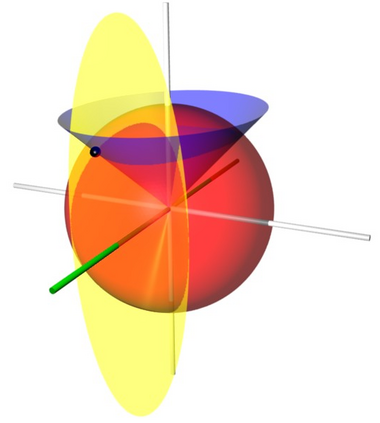Conical coordinates

Conical coordinates, sometimes called sphero-conal or sphero-conical coordinates, are a three-dimensional orthogonal coordinate system consisting of concentric spheres (described by their radius r) and by two families of perpendicular elliptic cones, aligned along the z- and x-axes, respectively. The intersection between one of the cones and the sphere forms a spherical conic.
Basic definitions
The conical coordinates are defined by
with the following limitations on the coordinates
Surfaces of constant r are spheres of that radius centered on the origin
whereas surfaces of constant and are mutually perpendicular cones
and
In this coordinate system, both Laplace's equation and the Helmholtz equation are separable.
Scale factors
The scale factor for the radius r is one (hr = 1), as in spherical coordinates. The scale factors for the two conical coordinates are
and
References
Bibliography
- Morse PM, Feshbach H (1953). Methods of Theoretical Physics, Part I. New York: McGraw-Hill. p. 659. ISBN 0-07-043316-X.
- Margenau H, Murphy GM (1956). The Mathematics of Physics and Chemistry. New York: D. van Nostrand. pp. 183–184. https://archive.org/details/mathematicsofphy0002marg.
- Korn GA, Korn TM (1961). Mathematical Handbook for Scientists and Engineers. New York: McGraw-Hill. p. 179. ASIN B0000CKZX7.
- Sauer R, Szabó I (1967). Mathematische Hilfsmittel des Ingenieurs. New York: Springer Verlag. pp. 991–100.
- Arfken G (1970). Mathematical Methods for Physicists (2nd ed.). Orlando, FL: Academic Press. pp. 118–119. ASIN B000MBRNX4.
- Moon P, Spencer DE (1988). "Conical Coordinates (r, θ, λ)". Field Theory Handbook, Including Coordinate Systems, Differential Equations, and Their Solutions (corrected 2nd ed., 3rd print ed.). New York: Springer-Verlag. pp. 37–40 (Table 1.09). ISBN 978-0-387-18430-2.
External links
 |

